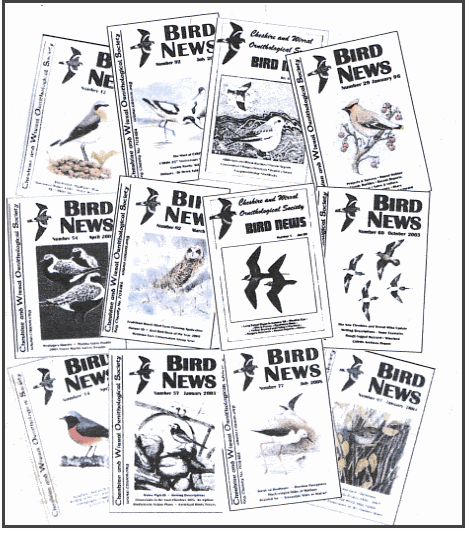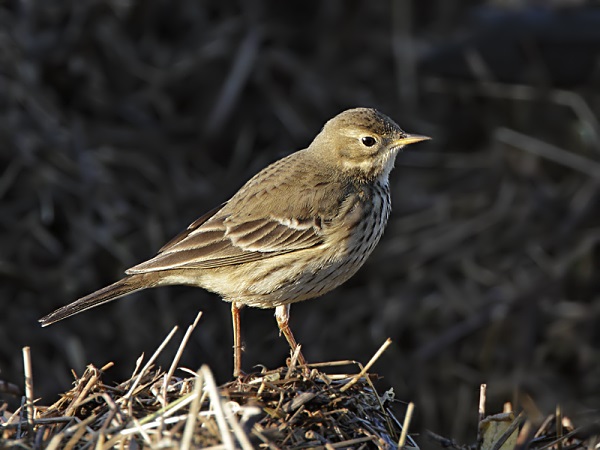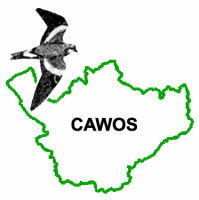
February 2014 Newsletter
Cheshire and Wirral Ornithological Society.
Cheshire and Wirral Bird Report 2012.
Postscript - The Great Storm of December 2013.
January Bird News.
Forthcoming Events (including Parkgate High Tides).
Latest Newsletter.
Who are we?
Founded twenty-five years ago, by a group of enthusiastic and committed birdwatchers, who wanted to continue and maintain the recording of Cheshire’s birds into the future, CAWOS is the leading ornithological society in Cheshire and Wirral and membership presently stands at 340. There are more than a few of the original committee members involved even now, but new blood and the computerisation of records have helped us keep abreast of the many changes since 1988 and to progress!
We are a registered charity and have
regular council meetings to
discuss all the matters on the table at the time, such as projects,
finance, the Annual Report, rarities, and to receive the reports from
various sub-committees. We report to our members at an Annual General
Meeting in March.
Why on earth?
CAWOS’ objectives are to promote and encourage the study and preservation of species and habitats within Cheshire and Wirral and with the help of a computer database, we have not only got a valuable resource for the Annual Report but also much data that remain unpublished but which are still an extensive researchable resource.
CAWOS’ founders knew that the valuable record of the Annual Report for Cheshire and Wirral was important as a continuous dataset to help monitor the avifauna of the county over time. Cheshire Bird Reports date back to the 1960s, and we now produce the much-applauded annual Cheshire and Wirral Bird Report, giving details of every species noted each year as well as specific papers, reports and pertinent articles. Other publications are available to members in the form of a thrice-yearly newsletter - Bird News - with regular features of recent sightings, places to watch, a diary of county-wide events and updates on surveys, projects, conservation issues, and notable ringing records.
A Gazetteer has been published as well, listing about 2000 sites where birds have been recorded and with maps and grid references it is a useful resource for members and volunteer fieldworkers alike.
The value of our fieldwork is exemplified in the relatively recent Birds in Cheshire and Wirral: A breeding and wintering atlas 2004-2007, strengthening our links with many individual birders and affiliated societies. An earlier breeding atlas 1978-1984 has served the county well, but with so many land use and environmental changes over the intervening twenty-five years, the need for a new body of work was compelling. The Atlas was published with the help of a grant from the Heritage Lottery Fund which has enabled us to work with our partners, Cheshire Wildlife Trust and Halton Borough Council, who used the survey data in educational programmes for young people.
Editor's Note: 'The C&W Atlas' as mentioned in the previous paragraph was judged 4th place in the prestigious British Birds/BTO Best Book of the Year in 2009 and in 2010 CAWOS was given the Marsh Local Ornithology Award by the BTO, the award is made to a bird club or group that publishes a book, completes a study or conducts any other exceptional activity that advances knowledge about birds. Remarkably, the Atlas is available free of charge on-line - see www.cawos.org.
Always willing to add to the database, records are our staple, and our combined knowledge enables comment on planning applications that threaten habitat loss or other disturbance. We can provide meaningful data for conservation purposes and we monitor planning applications in the various local authorities.
Each October, we start a varied and interesting programme of illustrated talks, normally on the first Friday of the month (open to non-members too). Usually held at Knutsford, we invite nationally-renowned speakers as well as local experts, and all enjoy the photography and shared knowledge, as well as socialising over refreshments during the interval.
CAWOS contributes to the work of national bodies, such as the BTO (surveys) and RSPB (data provision and nest watching for example), and at a more local level gathers the records of the county’s many varied societies, and supports, wherever possible, their various activities, watches and events.
Where?
Well, Cheshire and Wirral of course –
our home ground – which is as
rich and diverse as most counties in England. Indeed, with
the coast, internationally important estuaries, meres and ponds, plus
upland areas, we are blessed with a full range of opportunities to see
birds in so many habitats, and hence there is a super list of breeding
and wintering birds each year.
What else?
Through an agreement with Natural England, CAWOS manages the day-to-day operation of the A.W. Boyd Memorial Observatory overlooking Rostherne Mere. Members of the public can obtain annual or daily permits to get a grandstand view of the mere and the birds it supports. An Annual Report is produced, again a long-standing record of the birds of this National Nature Reserve, with its deepest (30m) and largest mere in Cheshire. Annual permits - £10 Single; £15 Family; £5 Concession, available via the Membership Secretary (contact details at the end).
The Rarities Team review and debate rare sightings and submit same to the British Birds Rarities Committee (BBRC) for national recognition and recording. We also periodically hold training sessions, conferences and exhibitions to promote birdwatching in general, to help fulfil our role and to ensure future interest and knowledge.
We welcome applications for financial
help on particular projects from
time to time and in the past these have ranged from support for the
publication of books, land preservation, material for ringing groups,
individual’s studies, and even providing food for feeding stations
too. Much of this is financed by Gift Aid from our members.
Thanks are due to the many members who enjoy giving their time to bring
together a valuable body of information each year and to their
support. As ever, the ageing stalwarts and the newer team
members now running the Society are looking for help with projects and
it is pleasing to look to the future and to engage with so many
birders. With the Atlas behind us we are looking to track
bird life on sites of note in the county and to continue and
to expand regular monitoring, which will enable us to help protect
habitats.
How much?
Membership of the Society is available
to everyone who are entitled to
free receipt of the annual Cheshire and Wirral Bird Report and the
newsletters. Adult £12pa; Corporate (includes affiliated
societies and supporting businesses) £12pa; Family £15pa; Junior £6pa.
Although the Cheshire and Wirral Bird Report is free to members and
posted out around the New Year, it can be obtained by non-members
through various outlets or from David Cogger, email:
davidcogger@cawos.org or tel: 01606 832517 at a cost of £9.50 (incl £2
p&p).
Gift
Aid - very welcome!
Records – very welcome!
Editor:
Submission of records is very
important. See www.cawos.org/submissionofrecords.htm for details. For 'Clwyd'
(Flintshire and Denbighshire) see the Clwyd Bird
Recording Group
Website. Non-rarities
can also be submitted via BirdTrack, but Rarity submissions MUST be
sent to the relevant county Rarity Panels (see the above websites for
details).
Charity No. 702484, www.cawos.org.
Anyone interested in the Society or
wishing to become a member can get
details from the Membership Secretary:
MRS S CANOVAN, 7 POWNALL ROAD, CHEADLE HULME, CHESHIRE, SK8 5AZ, Phil Hampson, 2 Winsfield Road, Hazel Grove, Stockport, Cheshire, SK7 6ES Email:
memsec@cawos.org.

Left: David Norman giving a talk on the changes in the Cheshire and Wirral bird life as demonstrated by the data in the first (1978-84) and latest (2004-06) Atlas.
Right: Colin Wells (RSPB Dee Estuary Manager) showing a graph demonstrating the huge increase in Little Egret numbers on the Dee Estuary over the past 15 years during his talk 'Work of the RSPB on the Dee and Changes in Little Egret Population'.
See further photos of this event - click here. (Photos by Sheila Blamire).
Cheshire and Wirral Bird Report 2012
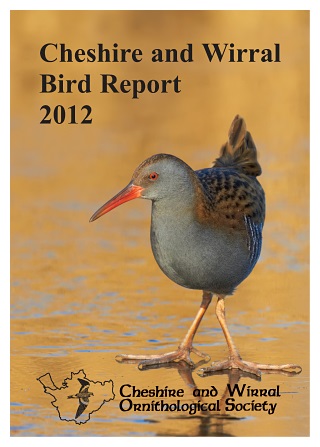
The Bird Report is full of interesting articles:
•
The well-researched article: ‘A Cheshire Centenary of Willow and Marsh
Tits’, summarises the changing fortunes in Cheshire and Wirral of the
two species, covering their identification, history, changing status
over the years in local population and distribution, habitat and
conservation.
• The rarity highlight of
the year was the discovery of a superb Little Swift at New
Brighton. This bird showed incredibly well and was the
longest-staying Little Swift on record in the UK and a much appreciated
first for Cheshire and Wirral.
• Another
fascinating article is the ‘Irruption of Coal Tits in autumn 2012’,
which indicates that the irrupting birds, found at sites with
peripheral (sub-optimal) habitat, were immatures, whilst the great
majority of Coal Tits in their core woodland habitat were adults.
•
An intriguing report of Lesser Black-backed Gulls and Herring Gulls
nesting on roofs in Crewe – this particular site has the potential to
expand in future years.
• Finally, a
tribute to Dr Derek William Yalden, who was a mammalogist, a
zooarchaeologist and an ornithologist, and with respect to each he had
an incredible impact. Also, we recognise what he did for
conservation and for his much loved Peak District.
All the
‘regulars’ are there: ‘Weather and Bird Review of the Year’; the full
‘Systematic List of Birds Recorded in Cheshire and Wirral during 2012’,
including ‘Category E Species’; ‘Early and Late Dates for Migrants’;
‘Ringing Report’; ‘Breeding Bird Survey Results 1994-2012’; ‘BBRC and
County Rarities Decisions’; ‘Chairman’s Review’; and finally, advice on
the Cheshire and Wirral Gazetteer, and the ‘Submission of Records’,
including rarities.
Last, but not least, we have again
included a ‘Species Index’ at the back to help you quickly look up your
favourite species. This will be invaluable because we’re now
using the new BTO order of species, which includes some major changes.
The
Bird Report is free to Cheshire and Wirral Ornithological Society
members (ordinary membership costs £12), otherwise it costs £8 + £2
p&p and copies are available from:
David Cogger, 113 Nantwich Road, Middlewich, Cheshire, CW10 9HD
Tel: 01606 832517 Email: davidcogger@cawos.org.
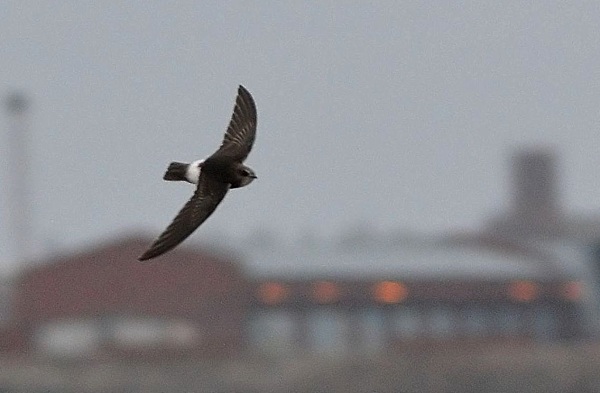
© Mike Davenport
Top of Page
Postscript - The Great Storm of December 2013
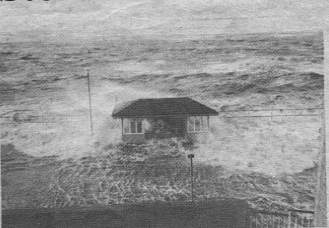
As well as the above photo more data has come to light for the December 5th storm surge and previous storms, all figures are for Liverpool Gladstone Dock:
The storm surge on December 5th 2013 was 1.25m, this was on top of a predicted height of 9.9m, making for an actual height of 11.15m. This equals the previous highest recorded tide which was on February 27th 1990; that day saw a storm surge of 1.15m added to a 10.0m predicted height. According to records I've seen the previous record high tides were in November 1977 and November 1905, which both reached a height of 11.1m.
There was another big storm surge on January 3rd this year (2014), the predicted height was 10.1m with a surge of 0.8m, given an actual height of 10.9m. It seemed to me that the difference at Burton Marsh between the Dec 5th and Jan 3rd tides was greater than the Liverpool figure of 0.25m, and it is probable that the December tide was blown further over the marsh because the wind was both stronger and blowing from the west rather than south west as on Jan 3rd; my estimate was that the December tide was higher by about 0.5m at Burton.
Everyone knows about the great storm of 1953 which flooded East Anglia with devastating affect. But it didn't seem to have been exceptionally high here in Liverpool Bay, presumably what storm surge there was didn't coincide with high tide here so we were spared the damaging floods. The wind direction was also crucial that day being from the north as the low pressure system tracked east, this resulted in the damaging surge down the North Sea. In contrast, we normally only get storm surges in Liverpool Bay when the wind is between north-west and south-west.
Sources of Information:
1. National Oceanography Center - see noc.ac.uk/news/storm-surge-hits-uk-coastline.
2. Reigate Grammar School Weather Station, see:
rgsweather.com/2013/12/08/storm-surge-december-2013-battle-won/.
3. B. Stephenson, Pers. Comm., Jan 2014.
Top of Page
January Bird News

The 3rd saw another storm surge, not as high as Dec 5th but high enough to completely cover Burton Marsh. Highlights that day were 12 Short-eared Owls (eight at Parkgate, four at Burton), a Little Gull at Wallasey Shore, at least four Water Rails and a Great White Egret at Parkgate, a Snow Bunting at Red Rocks and over 1,000 Pintail off Heswall. The previous day there were 2,500 Pink-footed Geese on Parkgate Marsh.
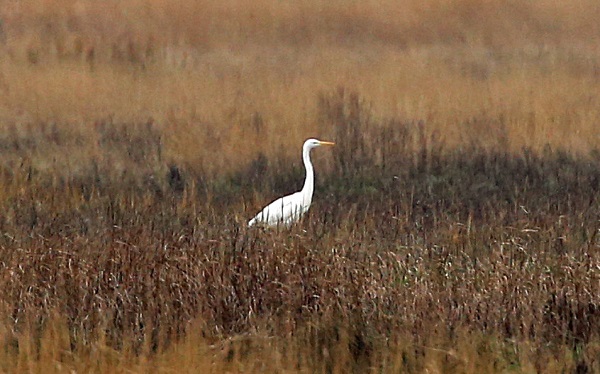
see Roy's Flickr page - http://www.flickr.com/photos/99817330@N02/
Good numbers of Twite were at the Connah's Quay Reserve with over 90 on the 1st the highest count. From Hilbre was seen a huge flock of 12,000 Scoter over towards the West Hoyle windfarm on the 18th, on the same day the highest count of Brent Geese was made with 230 and there was also a Great Northern Diver and Slavonian Grebe on the sea, the latter was also recorded on the 4th with 84 Red-throated Divers. 553 Great Crested Grebes off north Wirral on the 20th was easily the highest count of the winter so far.
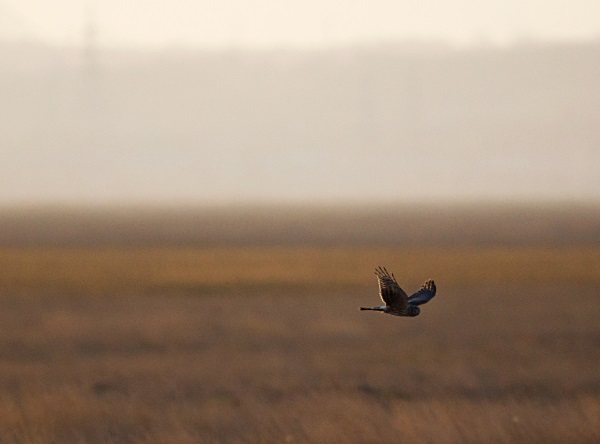
Richard Smith.
We are well overdue for a still cold spell so if we do get one expect an increase in wader numbers, especially Black-tailed Godwits, Knots and Sanderlings. Also a spell of still weather will be good for sea-watching, look out for large Common Scoter and Great Crested Grebe flocks, as well as various divers, Scaup etc.
Some years see huge numbers of gulls along north Wirral in February, in 2013 we had around 20,000 for a short period. These are mostly Herring Gulls but among them will be a handful of Mediterranean and Yellow-legged Gulls, and maybe Caspian, Glaucous and even an American Herring Gull.
Mild weather late in the month could see the return of some very early spring migrants. A Sand Martin is the most likely with possibly a Whimbrel or two.
Top of Page
February/March Highest Spring Tides (Liverpool)
Also
see Tides
page.
1st February, 12.00hrs (GMT), 10.2m.
2nd February, 12.45hrs (GMT), 10.2m.
3rd February, 13.29hrs (GMT), 10.0m.
1st March, 10.57hrs (GMT), 9.9m.
2nd March, 11.42hrs (GMT), 10.1m.
3rd March, 12.24hrs (GMT), 10.1m.
4th March, 13.06hrs (GMT), 9.9m.
Forthcoming Events
Organised by the Wirral
Ranger Service , Flintshire
Countryside Service, the
RSPB (Dee Estuary) and the Cheshire
Wildlife Trust:
All these events and walks have bird interest, even those not
advertised specifically for birdwatching. No need to book for these
events unless specified - please check below.
Also see 2014 Events Diary.
Most people have never seen a Hen Harrier, but once seen it is rarely forgotten. The RSPB are pleased to bring you a series of events to showcase these enigmatic birds of prey which use the marshes of the Dee Estuary as their home for the winter months.
The name "Skydancer" comes from the aerobatic displays that the male birds perform in their courtship ritual on the moors in the spring. Sadly, this is becoming an increasingly rare sight; they are close to becoming extinct as a breeding species in England, with not a single successful nest this year.
Come along to Parkgate to find out more about the hen harrier story and what you can do to help save them before it's too late! Look for the RSPB marquee along the main promenade at Parkgate, where friendly staff and volunteers will be on hand with telescopes and binoculars to show you these beautiful, agile birds hunting over the marsh, and coming in to roost there at dusk. Plenty of family activities and other RSPB information will be available.
Click here for dates and more details, or ring 0151 353 8478.
Saturday 1st February, Sunday 2nd February, Monday 3rd February.
RSPB Parkgate High Tide Watch.
Parkgate Marsh is one of the best wetland habitats in the northwest, and when it is flooded by an incoming Spring high tide, the wildlife which lives here is pushed closer, potentially delivering an awe-inspiring spectacle. Join us at Parkgate's Old Baths car park and the Donkey Stand near Nicholl's ice cream shop, where we'll be set up with marquees and telescopes hoping for the right weather conditions to really push the tide in.
You can expect great views of the large numbers of wintering wildfowl and wading birds shifting around to avoid the rising water, whilst the small mammals living on the marsh are flushed from cover, offering a feeding frenzy for the kestrels, harriers and short-eared owls.
Car parking is limited on Parkgate promenade and at the Old Baths car park, but the RSPB has arranged for extra free parking to be available for visitors at Marsh Nurseries on Boathouse Lane (CH64 6RD) and the Wirral Country Park car park on Station Road (CH64 6QJ).
It is recommended to arrive at least one hour before high tide.
High tide details: 1st Feb, 10.2m at noon; 2nd Feb, 10.2m at 12.45pm; 3rd Feb, 10.0m at 1.29pm.
Sunday 2nd February, 10.30am to 2pm.
Parkgate High Tide Bird Watch.
This is a Guided Walk led by Ecologist and well know local birder Jeff Clarke, and organised by the Cheshire Wildlife Trust www.cheshirewildlifetrust.org.uk.
This event is FREE but Booking is essential - ring 01948820728 to book your place.
We will concentrate on raptors, waders and wildfowl; with it being a 10.2m tide we may see a Water Rail or two and possibly some small mammals swimming for shore. In the nearby vicinity there will be many other birds to see including Skylarks, Rock Pipits, finches and possibly a few Scandinavian Thrushes. Once it reaches high tide we will walk down to the Donkey stand Flash and look for roosting waders.
Waterproof clothing and suitable walking footwear is recommended.
Meet at the Old Baths Car Park.
Sunday 2nd February, 1030am to 12.30pm, Winter Birds at Royden Park.
Join the Ranger and spend some time looking at our resident winter birds and gaining some hints on feeding and nest box locations.
Sorry no dogs.
Meet: Coach House/Court Yard at Royden Park.
Saturday 8th February 11:00am – 2:30pm
Take Tea on Hilbre with the RSPB
Walk across the sands to Hilbre Island where the RSPB will be serving tea and biscuits during the above date and time. They will be on hand to show you the island’s unique wildlife and will tell you about the work that the RSPB are doing at their fantastic reserve at Burton Mere Wetlands. There is no need to book, just turn up. Suitable clothing and footwear are essential for the walk out and please note – this is not a guided walk. Remember to bring money for the tea!
For further information, please telephone (0151) 648 4371.
Saturday 1st March, Sunday 2nd March, Monday 3rd March, Tuesday 4th March, RSPB Parkgate High Tide Watch.
Parkgate Marsh is one of the best wetland habitats in the northwest, and when it is flooded by an incoming Spring high tide, the wildlife which lives here is pushed closer, potentially delivering an awe-inspiring spectacle. Join us at the Donkey Stand on The Parade, where we'll be set up with our marquee and telescopes hoping for the right weather conditions to really push the tide in.
You can expect great views of the large numbers of wintering wildfowl and waders shifting around to avoid the rising water, whilst the small mammals living on the marsh are flushed from cover, offering a feeding frenzy for the kestrels, harriers and short-eared owls.
It is recommended to arrive at least one hour before high tide.
High tide details: 1st Mar, 9.9m at 10.57am; 2nd Mar, 10.1m at 11.42am; 3rd Mar, 10.1m at 12.24pm; 4th Mar, 9.9m at 1.06pm.
Saturday 1st March – 9:00am start - high tide 10.41am.
High Tide Birdwatch at Hoylake:
Join the Coastal Rangers, the Dee Estuary Voluntary Wardens and the RSPB to see the large numbers of wading birds on Hoylake beach. With a rising tide, we should see the birds at close quarters as they roost and feed. Beginners welcome. Dress warmly and bring binoculars if you have them.
Meet on the promenade at King's Gap, Hoylake.
For further information, contact the Coastal Rangers on 0151 648 4371.
Wednesday 5th March, 11am to 2pm, Waders on the Dee - a guided walk along Heswall and Thurstaston shore.
This is a Guided Walk led by Ecologist and well know local birder Jeff Clarke, and organised by the Cheshire Wildlife Trust www.cheshirewildlifetrust.org.uk.
This event is FREE but Booking is essential - ring 01948820728 to book your place.
Banks Road is where the marsh meets the mud and as consequence it has a great variety of waders to enjoy. Lapwings and Golden Plovers roost on the edge of the marsh, Common Redshanks fill the gutters and muddy banks, and Dunlins and Knots stitch the muddy areas along deep probing specialists like the Black Tailed Godwit. In addition the area is good for wildfowl and we may see Common Snipe flushed from cover.
Meet at Banks Road car park (near Sheldrakes Restaurant).
Friday
14th March
Wirral
Wildlife a local group of Cheshire Wildlife Trust
‘2013 - A Shorebird Summer’
Room B, Heswall Hall, Heswall, 7.30 p.m.
A
talk by Matt Thomas, local
Ranger and photographer, about his exploits in Norway and Iceland.
For some years Matt has been contributing sightings of colour ringed
waders he’s seen on the Dee Estuary to research projects based in
Norway and Iceland. In the summer of 2013 he was invited to join
expeditions to these countries to see where his Dee birds where coming
from. In the lands of the midnight sun he found much more to photograph
than those colour ringed birds!
Admission £3. All welcome.
